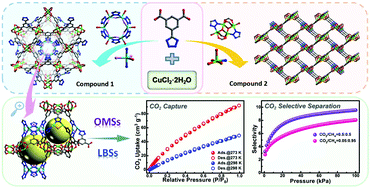Two novel porous MOFs, [Cu2Cl(TZI)(H2O)3]·4DMA (compound 1) and [Cu2(TZI)(OH)(DMF)]·DMF·H2O (compound 2) (H3TZI = 5-(tetrazol-5-yl)isophthalic acid, DMA = N,N-dimethylacetamide, and DMF = N,N-dimethylformamide), have been successfully synthesized using the same ligand consisting of isophthalate and tetrazolate groups and CuCl2·2H2O through the secondary building unit (SBU) strategy. Both compounds are constructed from copper cluster-based SBUs. Compound 1 is made up of two different cages based on a Cu paddlewheel and rare-reported double-crown like hexanuclear Cu cluster. In this SBU, the Cu atom adopts a five-coordination in a trigonal bipyramidal configuration, which is very rare in reported MOFs. Moreover, compound 1 with dual functionalities of open metal sites (OMSs) and N-rich Lewis basic sites (LBSs) exhibits good CO2 adsorption (92 cm3 g−1 at 273 K) and high-effect separation ability (9.6 for CO2/CH4 = 0.5/0.5 under 1 bar at 298 K).

